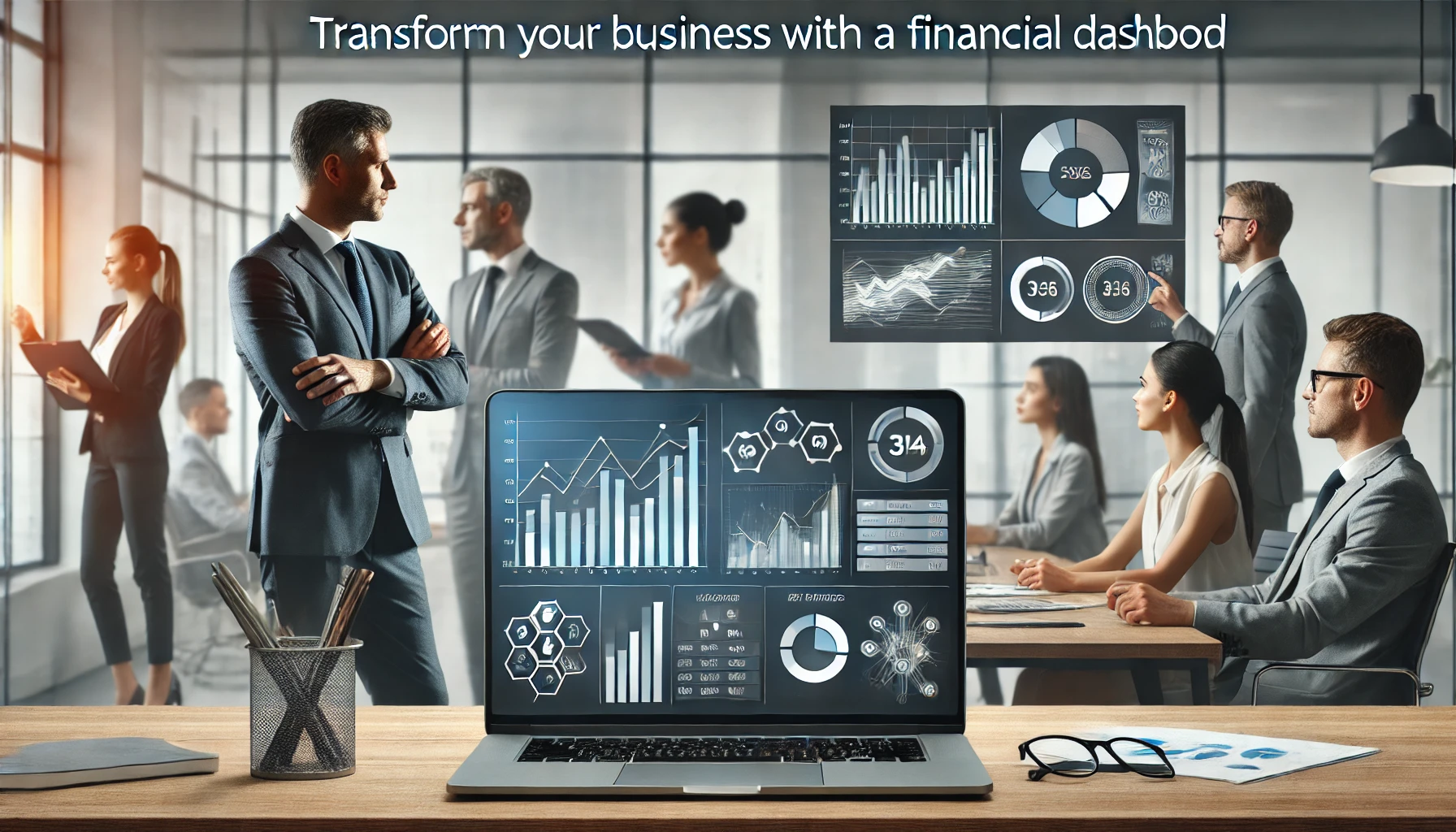In today’s fast-paced business environment, having a firm grip on your company’s financial health is more crucial than ever. An effective financial dashboard for business provides a clear, real-time view of your financial status, enabling better decision-making and strategic planning. Imagine having all the vital financial metrics of your company at your fingertips, presented in a visually intuitive format that simplifies complex data into actionable insights. This is not just a luxury for large corporations; it’s a necessity for businesses of all sizes.
Disclosure: If you click on my affiliate/advertiser’s links, I am going to receive a tiny commission. AND… Most of the time, you will receive an offer of some kind. It’ s a Win/Win!
Creating a financial dashboard for your company can seem like a daunting task, but it’s an investment that pays off significantly in terms of operational efficiency and strategic clarity. Whether you’re a seasoned financial expert or a small business owner new to the world of financial analytics, this guide will walk you through the essential steps to build a robust financial dashboard that meets your business needs.
A well-designed financial dashboard can revolutionise how you monitor and manage your company’s finances. It consolidates various financial data points, such as revenue, expenses, cash flow, and profitability, into a single, easily accessible platform. This integration not only saves time but also provides a comprehensive overview that helps identify trends, uncover insights, and make informed decisions.
Think about the time you can save and the precision you can achieve with a financial dashboard. Instead of sifting through endless spreadsheets and reports, you get instant access to key metrics. This shift from reactive to proactive financial management allows you to anticipate issues before they become problems and seize opportunities before they pass by.
In the following sections, we will explore how to create a financial dashboard tailored to your company’s specific needs. From choosing the right metrics and tools to designing a user-friendly interface, we will cover everything you need to know to set up a financial dashboard that will transform the way you run your business.
What are the aspects we are going to consider?
1. **Understanding the Importance of a Financial Dashboard**
– Discover why a financial dashboard is essential for modern businesses and how it can drive growth and efficiency.
2. **Key Metrics to Include in Your Financial Dashboard**
– Learn about the crucial financial metrics that should be part of your dashboard to ensure comprehensive financial monitoring.
3. **Choosing the Right Tools for Your Financial Dashboard**
– Explore the best software and tools available to create an effective financial dashboard tailored to your business needs.
4. **Designing a User-Friendly Financial Dashboard**
– Get tips on how to design an intuitive and accessible financial dashboard that your team will actually use.
5. **Customising Your Financial Dashboard for Your Business**
– Understand how to tailor your financial dashboard to reflect the unique needs and goals of your company.
6. **Integrating Data Sources into Your Financial Dashboard**
– Learn how to seamlessly integrate various data sources into your dashboard for real-time insights.
7. **Ensuring Data Accuracy and Reliability**
– Discover strategies to maintain the accuracy and reliability of the data displayed on your financial dashboard.
8. **Interpreting Dashboard Data for Strategic Decisions**
– Gain insights into how to interpret the data from your dashboard to make informed strategic decisions.
9. **Using Dashboards for Financial Forecasting**
– Learn how to leverage your financial dashboard to create accurate financial forecasts and budgets.
10. **Maintaining and Updating Your Financial Dashboard**
– Find out how to keep your financial dashboard current and relevant with regular maintenance and updates.
By following this comprehensive guide, you’ll be well on your way to creating a financial dashboard that not only enhances your understanding of your company’s financial health but also empowers you to make smarter, data-driven decisions.
Understanding the Importance of a Financial Dashboard
A financial dashboard for business is a game-changer in the realm of financial management. It consolidates all your critical financial data into one accessible platform, providing a holistic view of your company’s financial health. By leveraging real-time financial monitoring, businesses can promptly react to any financial anomalies, ensuring sustained operational efficiency.
Imagine having an executive summary of your business’s financial status at your fingertips. With key metrics like revenue, expenses, and profitability displayed visually, it’s easier to grasp complex data and make informed decisions swiftly. Without a financial dashboard, businesses risk relying on outdated information and cumbersome spreadsheets, which can lead to missed opportunities and financial mismanagement.
Key Metrics to Include in Your Financial Dashboard
Selecting the right metrics is crucial when creating a financial dashboard for your business. Key financial metrics include revenue, expenses, profit margins, cash flow, and return on investment (ROI). These metrics provide a comprehensive overview of your company’s financial performance, enabling more accurate financial forecasting and strategic planning.
For instance, tracking revenue and expenses can highlight trends in sales and identify cost-saving opportunities. Monitoring cash flow ensures you have sufficient liquidity to cover operating expenses and invest in growth initiatives. Including these metrics in your dashboard is essential for maintaining a clear picture of your financial health and making data-driven decisions.
Choosing the Right Tools for Your Financial Dashboard
The effectiveness of your financial dashboard depends significantly on the tools you choose. Various financial reporting tools, such as Microsoft Power BI, Tableau, and Google Looker Studio, offer robust functionalities for creating customised dashboards. These tools allow you to integrate multiple data sources and present information in an intuitive, visual format.
Choosing the right tool involves considering factors such as ease of use, compatibility with your existing systems, and the ability to scale as your business grows. For example, Microsoft Power BI offers powerful data integration capabilities, making it an excellent choice for businesses with complex data needs. On the other hand, Google Looker Studio provides a user-friendly interface suitable for smaller businesses.
Designing a User-Friendly Financial Dashboard
Designing a user-friendly financial dashboard is crucial for ensuring its effectiveness. The goal is to create a dashboard that is not only informative but also easy to navigate. Key considerations include a clean layout, intuitive navigation, and the use of visual elements such as charts and graphs to simplify data interpretation.
For example, using a bar graph to represent monthly revenue allows for quick comparison across different periods. Additionally, incorporating interactive elements like filters and drill-down options can enhance the user experience by allowing users to explore data in more detail. A well-designed financial dashboard ensures that users can easily access and understand the information they need to make informed decisions.
Customising Your Financial Dashboard for Your Business
Every business is unique, and so are its financial monitoring needs. Customising your financial dashboard ensures that it reflects the specific goals and requirements of your company. This involves selecting relevant metrics, designing bespoke reports, and integrating industry-specific KPIs.
For example, a retail business might focus on metrics such as inventory turnover and sales per square foot, while a service-based company might prioritise billable hours and client acquisition costs. Customisation enhances the relevance of your dashboard, making it a powerful tool for driving strategic decision-making and operational improvements.
Integrating Data Sources into Your Financial Dashboard
Integrating various data sources into your financial dashboard is essential for providing a comprehensive view of your financial status. This includes data from accounting software, sales systems, payroll, and other financial reporting tools. Seamless integration ensures that your dashboard reflects real-time data, enhancing its accuracy and reliability.
For instance, linking your accounting software to your dashboard can automate the flow of financial data, reducing the risk of errors and saving time on manual data entry. Proper integration also allows for more accurate financial forecasting and better strategic planning. Without it, you risk working with outdated or incomplete information, which can lead to poor decision-making.
Ensuring Data Accuracy and Reliability
The value of a financial dashboard lies in the accuracy and reliability of the data it presents. Inaccurate data can lead to misguided decisions and financial mismanagement. Implementing regular data validation checks and using reliable financial analytics tools can help maintain data integrity.
For example, reconciling your financial dashboard data with your accounting records periodically ensures consistency and accuracy. Additionally, establishing protocols for data entry and updating can mitigate the risk of errors. Ensuring data accuracy is paramount for building trust in your financial dashboard and making sound business decisions.
Interpreting Dashboard Data for Strategic Decisions
A financial dashboard for business is only as useful as your ability to interpret the data it presents. Understanding how to read and analyse dashboard data is crucial for making informed strategic decisions. This involves looking beyond the numbers to identify trends, correlations, and potential issues.
For example, if your dashboard shows a consistent decline in cash flow, it might indicate underlying operational inefficiencies or excessive expenses. By analysing this data, you can identify the root causes and take corrective actions. Effective data interpretation transforms your financial dashboard from a static report into a dynamic tool for strategic planning and growth.
Using Dashboards for Financial Forecasting
Financial forecasting is a critical aspect of business planning, and a well-designed financial dashboard can significantly enhance this process. By leveraging historical data and real-time metrics, you can create accurate financial forecasts that guide your strategic decisions.
For instance, a dashboard that tracks monthly revenue and expenses can help project future financial performance and identify potential cash flow challenges. This foresight enables proactive planning, ensuring that your business is prepared for various financial scenarios. Without accurate forecasting, businesses may face unforeseen financial difficulties and miss out on growth opportunities.
Maintaining and Updating Your Financial Dashboard
Maintaining and updating your financial dashboard is essential for keeping it relevant and useful. This involves regularly reviewing the metrics and data sources, updating the dashboard to reflect changes in business operations, and ensuring that the data remains accurate.
For example, as your business grows, you might need to add new metrics or integrate additional data sources. Regular updates ensure that your dashboard continues to provide valuable insights that support your business objectives. Neglecting maintenance can result in outdated information and reduced effectiveness, undermining the benefits of having a financial dashboard.
By following these detailed guidelines, you can create a powerful financial dashboard that not only enhances your understanding of your company’s financial health but also drives strategic growth and operational efficiency.
Conclusion and Summary: Elevate Your Business with a Financial Dashboard
Creating a financial dashboard for your company is a strategic move that can transform how you manage and understand your business’s financial health. This tool consolidates critical financial data into an accessible, real-time format, offering a comprehensive overview of your company’s performance. By focusing on key metrics like revenue, expenses, and cash flow, you can make informed decisions that drive growth and efficiency.
The journey begins by understanding the importance of a financial dashboard and selecting the right metrics that reflect your business goals. Customising these metrics to your specific industry and business model ensures that the dashboard provides relevant and actionable insights. The tools you choose play a crucial role in the effectiveness of your dashboard, making it essential to select software that integrates seamlessly with your existing systems and scales with your business needs.
Designing a user-friendly interface is another critical aspect. A well-designed dashboard not only looks good but also enhances usability, making it easier for you and your team to access and interpret data. This ease of use translates into better financial management, as complex data is presented in a visually intuitive way, allowing for quick analysis and decision-making.
Ensuring data accuracy and integrating various data sources are foundational to building trust in your financial dashboard. Regular data validation and seamless integration across platforms ensure that your dashboard reflects the most current and reliable information. This accuracy is vital for strategic planning, as it allows you to base decisions on solid data rather than assumptions.
Interpreting the data correctly and using it for financial forecasting further amplifies the benefits of a financial dashboard. By identifying trends and potential issues early on, you can proactively address challenges and seize opportunities. This proactive approach not only stabilises your financial operations but also positions your business for sustained growth and success.
Maintaining and updating your financial dashboard is the final piece of the puzzle. As your business evolves, so should your dashboard. Regular updates ensure that the tool remains relevant and continues to provide valuable insights that align with your current business objectives. This ongoing maintenance is crucial for keeping your financial strategies agile and responsive to changing market conditions.
Now is the time to take action. Start by assessing your current financial reporting processes and identify areas where a financial dashboard can add value. Choose the right tools, design an intuitive interface, and ensure data accuracy to build a dashboard that truly supports your business goals. By doing so, you’ll not only streamline your financial management but also gain a strategic advantage in today’s competitive business environment.
For more insights and practical advice on elevating your business acumen and improving your leadership and business skills, make sure to return to this blog. (Why not bookmark it now!) We regularly share expert tips and in-depth guides designed to help you navigate the complexities of business management and achieve your strategic objectives. Stay tuned and keep learning to keep growing. Your journey towards becoming a more informed and effective business leader starts here.
- Turn AI Anxiety into Competitive Advantage: How to Future-Proof Your Workforce for the AI Revolution
- Unlock Profit: Calculate Customer Lifetime Value & Maximize Growth
- Creating a Customer Persona: A Step-by-Step Guide On How To Do It
- Unleashing the Power of Digital Signage: The Best Software to Transform Your Business
- How Businesses Can Use Freelance Platforms & Expert Networks to Scale Smarter








